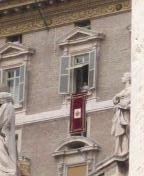Benedict benedictizing and Ara Pacis
These may be a bit out of order, so for reference this entry is for Sunday the 25th.
Andrea and I made another trip to the Vatican to try to get inside St. Peter's. Instead, we found a crowd of approximately one billion cheering people standing in the square listening to the Pope say mass or give a blessing. It wasn't entirely clear, but I'm guessing the latter. And when I say cheering, I mean literally cheering. With big banners, and lots of screaming in German at various intervals when the Pope broke into der Mother Tongue. See, this is what happens when the College of Cardinals lets the German guy to wear the big funny hat. The Poles were always much more sedate as pilgrims - always seemed to be saying quietly, "Ah yes, well, we're quite pleased we got be Pope this time, instead of, say, lined up and beaten. Very pleased, in fact." German pilgrims combine all the endearing qualities of German tourists (even *I* am embarassed) and the self-congratulatory boisterousness of a bunch of lads whose futbol team just won a match.
So we snapped a pic, said ha-ha to the idea of getting inside, and headed for the Ara Pacis.
Which was, in a word - magnificent. The whole thing, even its new Richard Meier building. I know, I know - everyone from armchair antiquarian to art-school ass-hat has an opinion on the museum building. Well, I got one too.. Not a half bad job, Dick. Could it have been executed better? Certainly. Was it thoughtless to put an expensive modern building on top of a possible cultural site? Probably. Is it better than any other building erected in Roma in the past 50 years. In my very limited experience, definitely. I'd love for someone to show me how very wrong I am by pointing out some stunning newer work, but from what I've seen so far, it's not bad at all. Of couse it's still new, with shiny white travertine un-cruddied by traffic and weather, so I reserve the right to change my opinion in a couple years.
The Ara Pacis itself is beautiful, and the story of it's recovery and assembly reads like only history (and no novel) can ever read. I was so inspired (by the project, as well as the altar) the I picked up a couple books in the musuem store.
And today was the day I got my phone to work.









